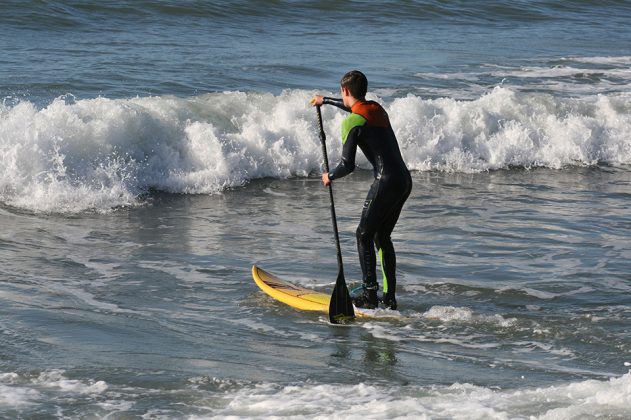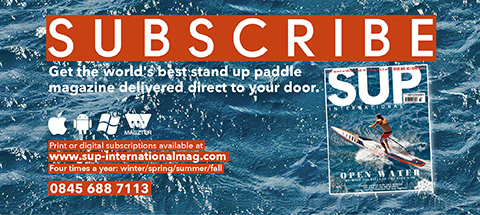BACK TO BASICS –
GETTING OUT THE BACK IN WAVES
First time paddling in waves, just getting off the beach can be tricky, painful, humiliating or just hilarious. After mastering flat water paddle boarding (a couple of times), I ventured out on a breezy day with my mate Tim C for our first taste of ‘wave SUP’. It was Nov ’07, we were on Starboard 12’6s and it was one of the funniest mornings I’ve ever had on the water. Both of us were experienced in the water, full of misplaced confidence and totally up for this new challenge.
We both made rookie error after rookie error, continuously falling off; the waves would stop the boards dead on the way out as we stared at them like a couple of lemons. Sure enough we stumbled forwards on our boards on the way out, paddle in hands, tumbling in on almost every wave. Every time I saw Tim going in head over heels I’d be doubled up laughing and end up falling in myself too.
Catching waves, we were getting washed off our boards backwards, dropping paddles, bogging the rails as we tried to surf the waist-high on-shore mush. Sure, teaching yourself can be a laugh, but with a few simple steps you can halve your learning time and gain far more respect from your peers in the water.
CHECK THE CONDITIONS
Ideally knee to waist high, glassy, clean, uncrowded surf is what you’re looking for. In reality your local spot when it’s not too windy and further down the beach away from the regular surfers is fine.
Think SPACE. If you’re new to waves stay away from other water users, especially surfers and swimmers. Most surfers can’t imagine anything worse than a middle age guy kneeling down on an eleven foot board bearing down on him as he’s trying to paddle out. It would be all too easy to accidentally knock out his front teeth or smash his prized surfboard, just for the sake of struggling to turn or being washed in by a wave. Space is our friend, let’s go and find some…
“ Anyone kneeling down paddling out is sending a message out that says they’re inexperienced or riding a board beyond their ability for the conditions. You’re always better off standing or using a bigger board ”
PADDLING OUT FOR THE FIRST TIME
What happens if we don’t have a plan?
Holding on to an 11 ft board is tricky, if it’s in front of you it’ll hit you every time a wave comes, then it’ll drag you backward by your ankle back towards the beach; great. If you lie down and paddle it, it’s tricky to hold the paddle too. When you kneel down on it, it turns easily, rears up like a spooked colt when a wave hits it and you get washed off. When you try and stand up, every time a wave hits, it flings you forward on to your knees at best, but usually just chucks you off.
Paddle out like a pro. Standing in the water hold, hold your board by the handle alongside you before you get on. You can push it over small waves by sinking the tail so the nose lifts and riders clear over the breaking surf. Once you’re deep enough that the fin definitely won’t catch, start paddling out: prone, kneeling and standing of course.
Paddling out prone has its uses such as getting you past an oncoming wave if you’re already in the water but it shouldn’t be your main technique. If you need to paddle prone just slip the paddle blade under your chest with the shaft pointing outwards and upwards. In choppy conditions on a small board prone paddling will come in handy but on big boards you’re always better off either standing or occasionally kneeling if required.
Kneeling down
Anyone kneeling down paddling out is sending a message out that says they’re inexperienced or riding a board beyond their ability for the conditions. You’re always better off standing or using a bigger board – both will improve your ability and balance. Plus you will gain respect from other water users around you and improve your technique and expand the conditions you can operate in. Practice, stand up, and don’t go back to your knees!
Stand up and paddle out
Firstly practice on flat water stepping from parallel stance to surf stance (one foot in front of other across board, but not along the centre line). You’ll be doing this a lot when paddling out through the waves so practice on flat will help develop the technique so that it becomes an instinctive reaction.
Very small (ankle slapper) waves can simply be paddled over without switching to surf stance, just paddle towards the wave and bend your knees and drag the paddle behind you for stability as you crest it.
That first proper wave paddle out
As you approach the wave paddle firmly and change your stance from parallel to surf stance. As you go over the wave, weight your back foot and the board will climb effortlessly over the white water. Once you’ve made it over simply change your feet from surf stance back to parallel stance and continue to paddle out towards the next wave. As you get further out the waves will get bigger, but just continue to switch to surf stance before each wave and paddle firmly till you get out the back.
OH S**T WHAT NOW? How to bail out
A sneaker set that’s twice as big as anything else swings in and suddenly you’ve got 5ft of white water about to mow you down. When you’ve no idea, you at first just try and paddle over it, usually getting dragged backwards by your ankle (although it’s possible to get over it with practice). Next time, you try to jump over the front of the board to get over the wave (simple enough you may think), this easily ends up with the board coming up and hitting you on the nuts or face (yep had both), it generally doesn’t work.
When it’s ‘wrong place, wrong time’, bail like a pro. Look before you bail. When paddling out, never paddle out in front of other water users as it’s too easy for the board to wash back and hit them. Always paddle to one side. Look again. You may have to kick your board left or right away from other people. If it’s clear, simply step off feet first to one side of the board, this will take you and your leash straight down and stop the board from getting washed back too far. In bigger waves you can dive head first (in deeper water) with your paddle and when you get pulled back by your board you can use your paddle as a lever to pop you back to the surface. This almost always prevents any long hold-downs.
Now you’re out the back, it’s time to catch some waves and see what SUP surfing is all about, long rides and big smiles… SUP


